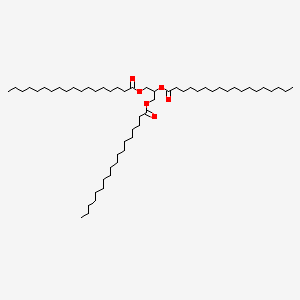



1. Glyceryl Tristearate
2. Stearic Acid Triglyceride
3. Tristearoylglycerol
1. 555-43-1
2. Glycerol Tristearate
3. Glyceryl Tristearate
4. Propane-1,2,3-triyl Tristearate
5. Trioctadecanoin
6. Stearic Triglyceride
7. Tristearoylglycerol
8. Triacylglycerol
9. Hardened Oil
10. Stearin, Tri-
11. Spezialfett 118
12. Stearoyl Triglyceride
13. Dynasan 118
14. Glycowax S 932
15. 2,3-di(octadecanoyloxy)propyl Octadecanoate
16. Stearic Acid Triglycerin Ester
17. Stearic Acid Triglyceride
18. Glycerol, Trioctadecanoate
19. 68334-00-9
20. Octadecanoic Acid, 1,2,3-propanetriyl Ester
21. Tg(18:0/18:0/18:0)
22. P6ocj2551r
23. 1,2,3-trioctadecanoyl-glycerol
24. 1,2,3-trioctadecanoyl-sn-glycerol
25. Propane-1,2,3-triyl Trioctadecanoate
26. Glyceryl Tristearate (nf)
27. Glyceryl Tristearate [nf]
28. Octadecanoic Acid, 1,1',1''-(1,2,3-propanetriyl) Ester
29. Hsdb 5690
30. Einecs 209-097-6
31. Hydrogenated Cottonseed Oil
32. Unii-p6ocj2551r
33. Ai3-01633
34. 1,2,3-propanetriol Trioctadecanoate
35. Pationic 919
36. Trioctadecanoylglycerol
37. Beta-tristearin (sss)
38. Glycerol Trioctadecanoate
39. Tristearin [ii]
40. Tristearin [mi]
41. Tristearin [hsdb]
42. Tristearin [inci]
43. Cottonseedoil, Hydrogenated
44. Ec 209-097-6
45. Schembl9507
46. Kemester 6000 (salt/mix)
47. Glyceryl Tristearate, >=99%
48. Glyceryl Tristearate, Technical
49. Dtxsid8047503
50. Propane-1,2,3-triyltristearate
51. Chebi:45956
52. Glyceryl Tristearate [fcc]
53. 1,2,3-propanetriyl Trioctadecanoate
54. Lmgl03010002
55. Mfcd00036230
56. Zinc85545202
57. Akos015899779
58. Beta-1,2,3-tri-octadecanoyl-glycerol
59. 2,3-bis(stearoyloxy)propyl Stearate #
60. As-11714
61. 1-stearoyl-2-stearoyl-3-stearoyl-glycerol
62. Hy-127035
63. Cs-0092148
64. Ft-0675675
65. G0212
66. D10637
67. D90727
68. Q425640
69. Tristearin, European Pharmacopoeia (ep) Reference Standard
| Molecular Weight | 891.5 g/mol |
|---|---|
| Molecular Formula | C57H110O6 |
| XLogP3 | 25.2 |
| Hydrogen Bond Donor Count | 0 |
| Hydrogen Bond Acceptor Count | 6 |
| Rotatable Bond Count | 56 |
| Exact Mass | 890.83024122 g/mol |
| Monoisotopic Mass | 890.83024122 g/mol |
| Topological Polar Surface Area | 78.9 Ų |
| Heavy Atom Count | 63 |
| Formal Charge | 0 |
| Complexity | 886 |
| Isotope Atom Count | 0 |
| Defined Atom Stereocenter Count | 0 |
| Undefined Atom Stereocenter Count | 0 |
| Defined Bond Stereocenter Count | 0 |
| Undefined Bond Stereocenter Count | 0 |
| Covalently Bonded Unit Count | 1 |
In the small intestine, most triglycerides are split into monoglycerides, free fatty acids, and glycerol, which are absorbed by the intestinal mucosa. Within the epithelial cells, resynthesized triglycerides collect into globules along with cholesterol and phospholipids and are encased in a protein coat as chylomicrons . Chylomicrons are transported in the lymph to the thoracic duct and eventually to the venous system. The chylomicrons are removed from the blood as they pass through the capillaries of adipose tissue. Fat is stored in adipose cells until it is transported to other tissues as free fatty acids which are used for cellular energy or incorporated into cell membranes.
Cosmetic Ingredient Review Expert Panel; International Journal of Toxicology: 20 (suppl. 4): 61-94 (2001)
When 14C-labeled long-chain triglycerides are administered intravenously, 25% to 30% of the radiolabel is found in the liver within 30 to 60 minutes, with less than 5% remaining after 24 hours. Lesser amounts of radiolabel are found in the spleen and lungs. After 24 hours, nearly 50% of the radiolabel has been expired in carbon dioxide, with 1% of the carbon label remaining in the brown fat. The concentration of radioactivity in the epididymal fat is less than half that of the brown fat.
Cosmetic Ingredient Review Expert Panel; International Journal of Toxicology: 20 (suppl. 4): 61-94 (2001)
The absorption of [1- 14C]tristearin was evaluated using groups consisting of six to seven male Wistar rats (weights =200 to 250 g). The rats were prepared either with an external bile fistula or a sham operation (control group), and then allowed to recover for 6 to 12 hours. Weighed doses of [1- 14C]tristearin were fed in a pellet of bran. Doses of 25, 50, 100, and 200 mg were administered to four groups, respectively. The rats were killed after 16 hours and lipid from the stomach, small gut, and colon (with feces) was extracted. Absorption was expressed as the percentage of the dose that had left the stomach. Only rats in which 80% or more of the dose had left the stomach were used. Tristearin absorption was classified as poor at all administered doses. Significantly lower absorption of tristearin was noted only in the 200 mg dose group ( p <.02, n=6)
Cosmetic Ingredient Review Expert Panel; International Journal of Toxicology: 20 (suppl. 4): 61-94 (2001)
Feeding expt with (14)C-labelled tristearin indicated that ruminal bacteria actively hydrogenated, degraded, and synthesized fatty acids. Stearic acid seemed to be absorbed from small intestine at slower rate than other fatty acids.
Miller LG, Cramer DA; J Anim Sci 29(5) 738 (1969)
Hydrolysis of /Tristearin/ by hepatic triacylglycerol lipase in plasma from ICR mice has been demonstrated in vitro.
Cosmetic Ingredient Review Expert Panel; International Journal of Toxicology: 20 (suppl. 4): 61-94 (2001)